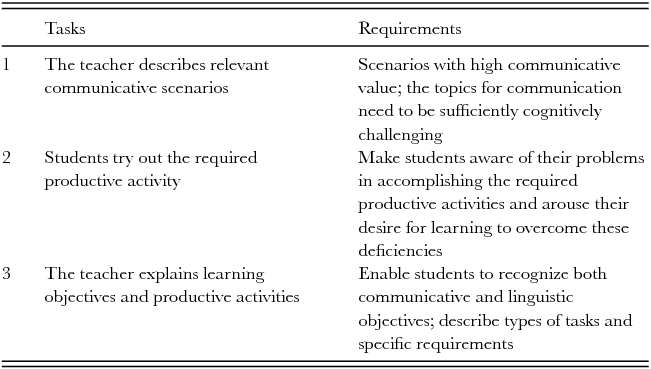| The production | 您所在的位置:网站首页 › Task-based teaching approach › The production |
The production
|
4.3 Teaching procedures Teaching with the POA consists of three phases: (1) motivating; (2) enabling; and (3) assessing. All three phases are mediated by teachers, whose mediating roles include guiding, designing, and scaffolding in addition to being a facilitator and a consultant. To help teachers implement these teaching procedures without too much difficulty, iEnglish structures each unit so that the teacher has a blueprint to follow, as presented in Figure 1. iPrepare matches with the first phase, iExplore with the second phase, and iProduce with the third phase. 
Figure 1 Structure of one unit of iEnglish 4.3.1 MotivatingMotivating is the initial phase of the POA, making it different from other teaching approaches from the outset. Table 1 presents specific tasks with requirements during the first phase of instruction. Table 1 Tasks and requirements of the first, motivating phase  Unlike the ‘lead-in’ or ‘warm-up’ activity in traditional language teaching, the first step of this phase of the POA expects the teacher to make explicit the scenarios of to-be-finished tasks and how they plausibly might happen in students’ future lives. Take ‘Art and Nature’, Unit 2, Book 2 of iEnglish, for example. Two scenarios are described by the teacher (Yang Reference Yang2015). Situation 1: You and your foreign friend are talking about art in the West and in China. You are discussing with your friend the major features of Da Vinci's Mona Lisa and Chinese paintings of mountains and water. Situation 2: Your school is going to hold an international students’ forum. The theme is ‘East and West – Similar or Different’. The forum is to promote understanding of Western art and Chinese art. You are attending the painting symposium and are going to give a presentation. The presentation will be about the similarities and differences between Western and Chinese painting. What would you say? To vividly enact the authenticity of the above scenarios, Yang chose to produce a video-tape for the first scenario where one Chinese student and one foreign teacher were invited to talk about the Mona Lisa and Chinese paintings of mountain and water. The Chinese student knows little more than the mysterious smile of the Mona Lisa. As for why most classical Chinese paintings depict mountains and water, she was caught blank. After watching the video-tape, students would naturally think about themselves and the extent to which they could perform the tasks. The POA assumes that if students realize their weaknesses, they, as adults, would like to learn more in order to avoid embarrassment and perform more effectively in the future. This kind of assumption, however, needs to be dealt with cautiously since it may be culturally sensitive. The second step of the first phase is to ask students to try out the designated productive tasks. Through the students’ initial trial, the POA hopes that students come to know specifically what they lack for the tasks: Do they lack sufficient knowledge about the topic? If they do have adequate knowledge, do they know how to express it in English? Are they able to organize information in an appropriate way? Their deficiencies might appear in one or two or all three areas. Once students can identify their difficulties, they will have a clear focus for their learning. The last step of this phase is to explain what students are expected to achieve at the end of the unit. The POA emphasizes a balance between realistic and obtainable communicative and linguistic objectives. In this sense, learning objectives necessarily vary according to students’ diverse abilities in English. The following are the communicative objectives of Unit 2 ‘Art and Nature’ set up by Yang (Reference Yang2015): • Name and explain some features of a world-famous Western painting. • Identify and analyze the subject matter in classical Chinese paintings. • Make comparisons between Western and Chinese paintings from one or more perspectives. Linguistic objectives include both language expressions and discourse structures. For language expressions, the POA suggests that the teacher list only the most essential words, expressions, and sentence structures to be mastered and closely related to the needs of accomplishing the assigned productive tasks. For discourse structures, although they might be various, students are expected to be able to use at least the most frequent and basic ones. A common implementation problem is that teachers may ask students to learn all the new items occurring in the text. However, if too many linguistic items are expected to be acquired, the results might contradict the SLH principles of the POA, and students’ confidence and interests in learning might be diminished if they feel they cannot meet the teacher's expectations no matter how hard they work. 4.3.2 EnablingThe second phase of the POA is called ‘enabling’, which means instruction must follow a series of steps designed by the teacher to lead students from being less to more able. This phase relates to the IEH and the SLH hypotheses described above. The IEH highlights the link between learning and using language while the SLH stresses how to learn selectively for a specific production purpose. This phase is the essential part of the POA. On the one hand, all the teaching principles are primary in this phase. At the same time, the IEH and SLH are brought to the fore and tested in this phase (e.g. Zhang Reference Zhang2016). Traditional Chinese teaching places too much emphasis on learning without enough attention paid to using language whereas Western, task-based or project-based approaches put too much stress on using language without teachers providing students with systematic guidance for learning. During this enabling phase, the POA maintains that teachers should not simply or arbitrarily assign productive activities to students but rather find ways to guide students in learning step-by-step from their existing knowledge base, in a ZPD, expanding their linguistic systems and rhetorical devices gradually and progressively (Wen Reference Wen2015c). In the Chinese context, textbook writers have responsibilities for selecting input materials that help learners complete the assigned productive activities successfully. From my personal experience of textbook writing, it is extremely difficult to find input materials that match 100% with the designed productive activities. On the other hand, textbook writers do not actually want materials with 100% matching because students need to learn how to process new materials and find out what they need for language production. Therefore, the criterion for selecting enabling input materials is relevance rather than matching. In addition to the materials provided by textbooks, the POA also expects a teacher to find suitable materials from websites or for students to search the internet for relevant materials under the teacher's guidance. Adequate materials provide students with relevant ideas, language expressions, or discourse structures for the assigned productive activity. The POA does not want to provide input materials for learners just to imitate. For each unit of iEnglish, there are two texts as enablers. Again, take ‘Art and Nature’ as an example. Text A is about the Mona Lisa and Text B about classical Chinese paintings. The exercises include three types. The first type centers on identifying and synthesizing information, which helps students obtain crucial ideas from the text relevant to the productive activity. The second type is for building students’ language. The exercises within this type are various. The basic assumption is that although the text provided has many new words, expressions, and sentence structures, the textbook writers only focus on the most important ones and design several rounds of exercises from comprehension to production, encouraging students to learn important material step-by-step. There is also an extended box to supplement sentence structures that do not occur in the text but are useful for the productive tasks. The third type prepares students for the key discourse structure in the unit, normally, through an exemplary essay or speech produced previously by a student or a teacher on a similar but different topic. For example, if the productive task is to talk about the Mona Lisa, the preparatory listening or written materials are about another painting, the Last Supper. The students are expected to analyze the given materials and summarize their organizing structure. Model, exemplar texts by students or teachers are assumed, by the POA, to be more learnable and within students’ ZPD than would be texts published by famous native speakers of English. My observations of English class instruction indicate that the second enabling phase is more demanding than the motivation or assessing phases. Instead of carefully guiding students to learn step-by-step, Chinese English teachers either give their students explanations or ask their students to provide answers to the questions in the exercise at the end of each text. Thus, their teaching does not involve a series of carefully designed procedures in which students are guided to learn new things progressively. Consequently, the enabling phase requires teachers spend considerable time understanding and preparing to follow the requirements of this enabling phase. Table 2 illustrates the specific tasks and requirements of the enabling phase. Table 2 Tasks and requirements of the second, enabling phase  As Table 2 shows, the enabling phase of the POA consists of four major steps which can be rearranged and repeated according to the pedagogical situation. Teachers are often encouraged to segment a large productive activity into several mini-ones. For example, the overall productive activity for ‘Art and Nature’ is to make comparisons between Western and Chinese paintings from one or more perspectives. To accomplish this extended activity, students must first finish two sub-activities – talking about Western paintings and about Chinese paintings – that enable them to carry out the longer activity. Accordingly, teachers need to plan at least three cycles of instruction, each repeating the four steps in Table 2. 4.3.3 AssessingHere, assessment can be grouped into two kinds. The first is ongoing diagnostic and formative classroom assessment that takes place in the enabling phase when students do selective learning or practice their mini-productive tasks. Based on the result of the ongoing diagnostic and formative assessment, the teacher should adjust the pace of instruction. The second is achievement assessment, which refers to the assessment undertaken at the next round of classes through students’ repeated practice outside class to check whether the students have achieved the objectives of the unit learned. Table 3 presents the tasks and the requirements of achievement assessment. Table 3 Tasks and requirements of achievement assessment  The last phase of the POA is to assess students’ language products, which might be written compositions, public speeches, translated texts, oral interpretations, simulated role plays, posters, and so on. The first step to this end is to set up criteria for assessment jointly among the teacher and students. Rather than constructing criteria for different types of language products at one go, it is better to construct sets of criteria while evaluating a particular type of language product. The criteria should be explicitly stated and easily comprehended so that students can make self-evaluations without difficulty. The second step is for students to submit their finished products. A deadline and format must be clearly specified in advance so that students’ submitted products are presented in a required format and handed in on time. The third step is the most crucial, involving collaborative assessment. The teacher organizes the assessment, whether in oral or written format, by selecting a few typical student products (without mentioning the students’ names) to be evaluated in class. For effective collaborative assessment, the teacher needs to prepare detailed evaluations of all students’ products before class. Then, in class, the students may first make comments and make revisions in pairs or groups, followed by whole-class discussion. In between these steps, the teacher may make comments on or prepare revised versions of the students’ products. Importantly, different revised versions should be compared and discussed as to why one version is better than another. This kind of collaborative assessment can lead to better learning outcomes than a teacher's individual feedback. On the one hand, the teacher can discuss common problems together among students; on the other, all the students’ attention can be aroused to influence maximally the teacher's corrective feedback on all students. The last step is to evaluate those products that have not been assessed in class, inviting all to participate in this after-class evaluation, each student scoring one or two other students’ productive work with detailed guidance from the teacher. The teacher's assessment is always needed along with these students’ evaluations. Each student's products can be put together with their assessment records throughout the term in a portfolio, which serves a double purpose. Students can review their own progress within a semester, and the teacher can use this portfolio for the purposes of formative and achievement assessments and grading. |
【本文地址】